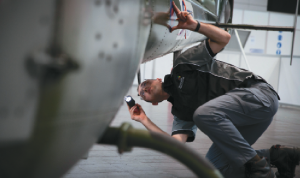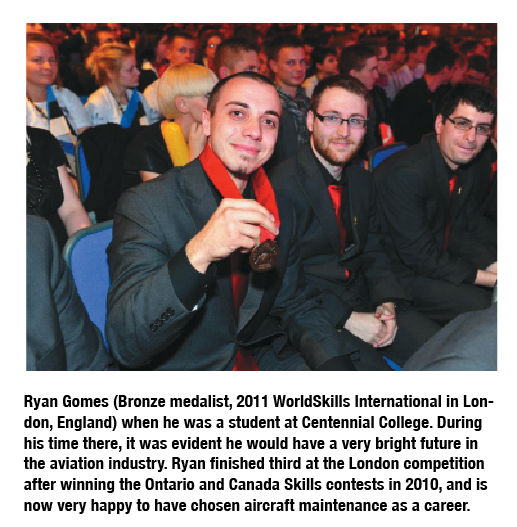Bringing On Their A-Game
LOUIS ANDERSON, AME, A&P, MT
Instructor, Centennial College
Young tech talent is stepping up to the plate and doing Canada proud in international trades skills events. They are the industry’s future, and here’s how you can help them make an impact.
Aircraft maintenance is what AMU magazine is about. Readers of AMU are typically those of us involved in the industry, one way or another. Most who read this publication are proud to be involved in this industry (most of the time) and would like to do whatever we can to ensure that our safety record continues to improve. One approach to ensuring the safety of the flying public is to help develop the talents of the youth who have chosen to become involved in this industry. With that in mind, I would like to introduce you to a set of competitions that focuses on developing “the best of the best”.
Every year, young people from elementary, secondary and post-secondary programs from schools across Canada gather at regional/provincial skills competitions. These students vie against other youth in their respective skilled trades or technologies, with the opportunity for winners to move on to national, and even international, competitions. Aircraft Maintenance is one of the hotly contested fields. It is classified as a post-secondary competition and, as such, students who are enrolled in Aircraft Maintenance Basic Training courses in community colleges can apply to compete in their respective regional/provincial competitions. The winners may advance to the Skills Canada National Competition (SCNC), which this year will be staged June 4-7 at the International Centre in Toronto. Those who emerge victorious at the national level will then be invited to challenge at the 2015 WorldSkills International competition in São Paulo, Brazil.
One of the provincial qualifier competitions is the Skills Canada-Ontario OTSC (Ontario Technological Skills Competition). This competition is typically held every spring at the RIM Park/Manulife Financial Sportsplex in Kitchener, Waterloo. OTSC is the largest of the regional skills contests in Canada, bringing together some 1,900 competitors in over 60 individual skilled trade categories. The Aircraft Maintenance competition (first introduced to this competition in 2003) typically draws six to eight students each year who are currently enrolled in an Aircraft Maintenance program at any of Ontario’s many fine post-secondary education facilities. This year, two participants from each of four community colleges were enrolled in the competition. The participating schools were Canadore, Centennial, Confederation, and Mohawk colleges.
The Aircraft Maintenance contest consists of five typical aircraft maintenance tasks such as magneto timing, sheet metal repair, aircraft inspection, a weight and balance report, and air regulations. In a somewhat different twist, the contest also includes a job interview with a professional HR representative, complete with resume submission. Industry volunteers grade each of the individual contests. The results are tabulated by the technical chair(s) and confirmed by each volunteer expert. When all is said and done, a winner is announced. The winner of the Ontario Aircraft Maintenance Competition is, of course, then invited to the national Skills Canada competition to compete against their counterpart winners from the other regional/provincial competitions.
The participants in these contests are the “cream of the crop” in their respective industry and are typically very motivated youth. It is these ladies and gentlemen who will be the future of the aircraft maintenance industry in Canada. I had the pleasure of instructing Ryan Gomes (Bronze medalist, 2011 WorldSkills International in London, England) when he was a student at Centennial College. During his time there it was evident he would have a very bright future in the aviation industry. Ryan finished third at the London competition after winning the Ontario and Canada Skills contests in 2010, and is now very happy to have chosen aircraft maintenance as a career, even though he originally planned to study automotive mechanics.
 “I would like to encourage any young person who qualifies for this contest to give it a try,” said Mr. Gomes. “It is a lot of work but a very rewarding experience …you learn so much when you participate in a skills competition at any level, the people you meet both personally and professionally are awesome. I would like to thank all the people who helped me prepare for the WorldSkills competition.”
“I would like to encourage any young person who qualifies for this contest to give it a try,” said Mr. Gomes. “It is a lot of work but a very rewarding experience …you learn so much when you participate in a skills competition at any level, the people you meet both personally and professionally are awesome. I would like to thank all the people who helped me prepare for the WorldSkills competition.”
 Bryan Everts of Maple Ridge, BC was the silver medalist in 2009 when WorldSkills was held in Calgary, Alberta. He says he’s more than happy he decided to study Aircraft Maintenance at the British Columbia Institute of Technology, and landed a job with Conair upon graduation. “The work is definitely fulfilling and the starting wage is pretty good. Best of all, I get to do what I love to do,” said Mr. Everts during an interview archived at www.apprenticesearch.com, which is a free service operated by not-for-profit organizations and community agency partners in Ontario.
Bryan Everts of Maple Ridge, BC was the silver medalist in 2009 when WorldSkills was held in Calgary, Alberta. He says he’s more than happy he decided to study Aircraft Maintenance at the British Columbia Institute of Technology, and landed a job with Conair upon graduation. “The work is definitely fulfilling and the starting wage is pretty good. Best of all, I get to do what I love to do,” said Mr. Everts during an interview archived at www.apprenticesearch.com, which is a free service operated by not-for-profit organizations and community agency partners in Ontario.
What are Canada’s chances in future WorldSkills competitions, which are held every other year, such as the 2015 event in São Paulo? Time will tell. But with proper support and development opportunities, the current and future Aircraft Maintenance Technicians of Canada can compete with the best the world has to offer.
 Many other countries have development programs where young people are rewarded with scholarships, bursaries and, in some cases, even type specific courses provided free of charge to help apprentices expand on their basic skills. In making a comparison of Canada to the rest of the world, one can quickly and correctly see that despite our success in the WorldSkills events, the Canadian aviation industry as a whole could do a much better job of supporting and nurturing our next generation maintenance professionals.
Many other countries have development programs where young people are rewarded with scholarships, bursaries and, in some cases, even type specific courses provided free of charge to help apprentices expand on their basic skills. In making a comparison of Canada to the rest of the world, one can quickly and correctly see that despite our success in the WorldSkills events, the Canadian aviation industry as a whole could do a much better job of supporting and nurturing our next generation maintenance professionals.
Thanks to my teaching career I see, first-hand, many students in the post-secondary education system who would benefit from some sort of recognition in the aviation industry. Unfortunately, some of these very intelligent, young professionals end up leaving the field altogether for the greener pastures or careers with more recognition, better compensation, and more promising advancement opportunities.
I sincerely hope that you, the AMU reader, can make some type of impact to ensure that Canada continues to be a great place to ply the trade of Aircraft Maintenance Technician.
About WorldSkills International
Formerly known as the Skills Olympics, WorldSkills International was established in 1950 in Madrid, Spain, by José Antonio Elola-Olaso. The event has come to symbolize the pinnacle of excellence in vocational training. Now more than 50 countries participate in the biennial event, with Aircraft Maintenance added as a competition in 2009. Because of its youth focus, a contestant in WorldSkills competition cannot be a certified journey person in the contest area in which they wish to compete, and must be under the age of 25 for those in the Aircraft Maintenance competition. The last WorldSkills competition took place in 2013, and was hosted by Leipzig, Germany. The 43rd edition is slated for São Paulo, Brazil, in 2015. For more, visit www.worldskills.org
How can AMU readers help develop young talent?
1. Send your support to our Canadians competitors in international events.
2. Offer to volunteer at your local Skills event.
3. Offer to be a mentor for a competitor (at any level of the Skills contests).
4. Support the Skills program through volunteer assistance to Skills Canada.
5. Promote the Skills program among the youth in our industry.
6. Consider sponsoring regional/provincial/national competitions,
either personally or through corporate support of the event(s).
For more, visit www.skillscompetencescanada.com
Canada’s success at WorldSkills-Aircraft Maintenance
Canada has fared very well since Aircraft Maintenance was introduced as a WorldSkills International event.
Here’s a snapshot of the results:
• 2009: Brian Everts (Maple Ridge, BC) finished second (silver) at the WorldSkills competition hosted in Calgary, Alberta
• 2011: Ryan Gomes (Cambridge, Ontario) finished third (bronze) in London, UK.
• 2013: Dylan Pereira (Winnipeg, Manitoba) earned the Medallion for Excellence at the 42nd WorldSkills competition in Leipzig, Germany.
Back to the basics
Here’s your brain-buster for the day. Below are three standard skill-testing questions posed to competitors in Aircraft Maintenance Skills events. How would YOU do?
1. The E Gap (or Efficiency Gap) position of the Otto Cycle reciprocating internal combustion engine magneto’s rotating magnet is defined as:
a. The specific number of degrees of rotation beyond the full register position of the rotating magnet, where the greatest magnetic field strength exists.
b. The specific number of degrees of rotation beyond the full register position of the rotating magnet, where the greatest magnetic field stress exists.
c. The specific number of degrees of rotation beyond the neutral position of the rotating magnet, where the greatest magnetic field stress exists.
d. The specific number of degrees of rotation beyond the neutral position of the rotating magnet, where the greatest magnetic field strength exists.
2. While completing a magneto check, the ignition switch is selected to “Left” and the engine RPMs drop to zero … the problem would be:
a. A short in the circuit between the ignition switch and the magneto.
b. An open circuit between the ignition switch and the magneto.
c. Nothing, this is a normal condition when selecting only one magneto.
d. A short in one of the wires in the circuit between the distributor cap and the plug.
3. Indicated horsepower (IHP) is defined as:
a. The actual amount of power delivered to the propeller shaft.
b. The power required to overcome the friction and energy losses in the engine.
c. The total power actually developed in an engine’s cylinder(s), ignoring friction losses in the engine.
d. None of the above.
– the end
















































